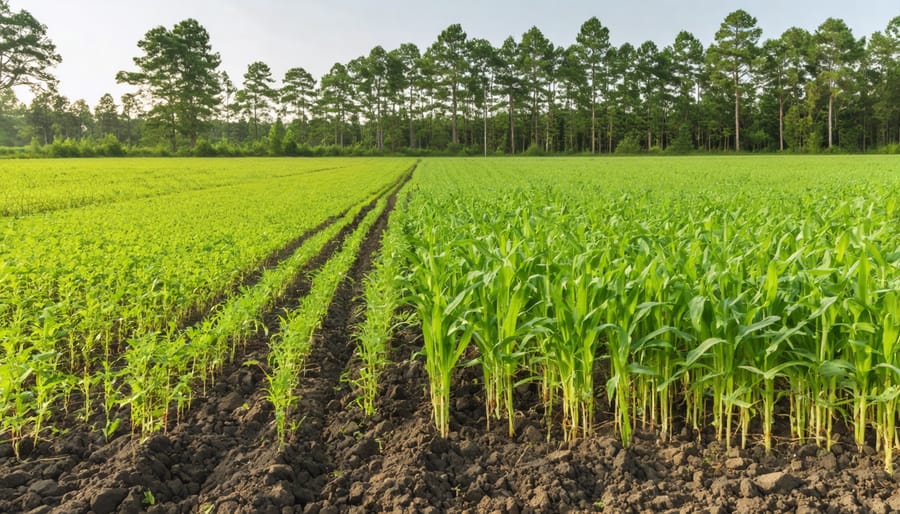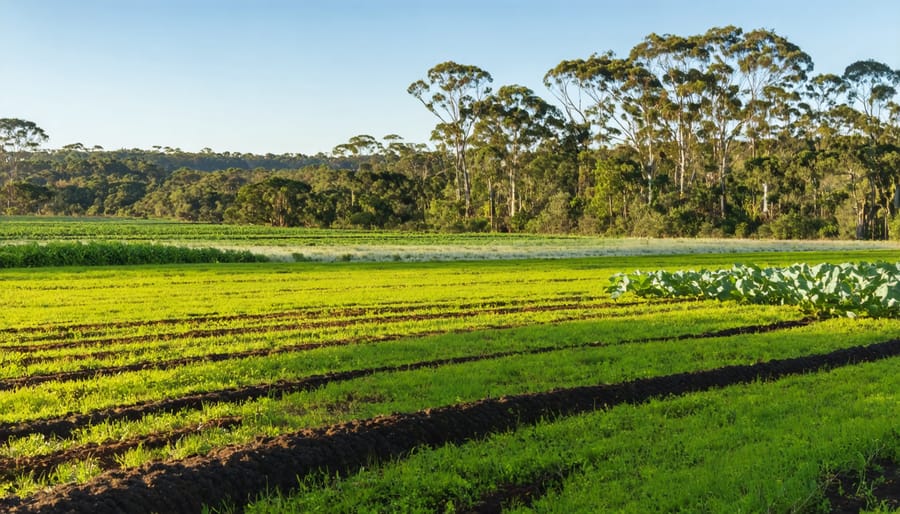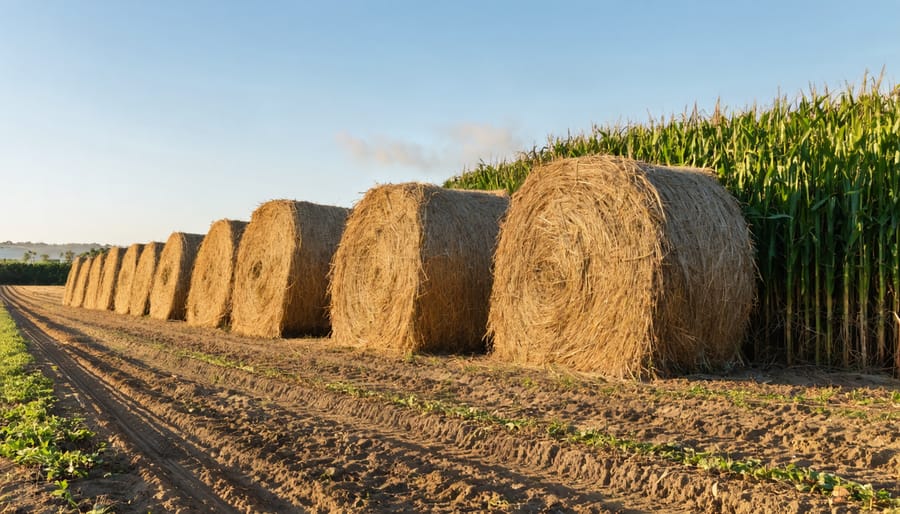# The Environmental Impact of Biomass: Balancing Opportunity and Responsibility
Australia stands at a crossroads in its energy journey. Biomass energy—power generated from organic materials like agricultural waste, wood chips, and dedicated energy crops—promises to reduce our carbon footprint while supporting regional economies. Yet the environmental story of biomass isn’t simply written in black and white.
When done right, biomass production can transform degraded farmland into productive ecosystems, capture carbon that would otherwise enter the atmosphere, and turn waste streams into valuable energy resources. Australian farmers from Queensland’s sugar cane regions to Western Australia’s wheat belt are already discovering how biomass crops can restore soil health while generating additional income streams.
However, the picture grows more complex when we examine land use changes. Converting native forests or prime agricultural land to biomass production can release stored carbon, threaten biodiversity, and disrupt water cycles. The bioenergy market dynamics—driven by renewable energy targets and international carbon markets—create powerful economic incentives that sometimes clash with environmental stewardship.
The critical question isn’t whether biomass should play a role in Australia’s energy future, but how we harness its potential responsibly. Understanding both the environmental benefits and challenges allows policymakers, landholders, and industry professionals to make informed decisions that protect our natural heritage while building a sustainable energy system.
This article explores the multifaceted environmental effects of biomass production, drawing on Australian case studies and practical solutions that demonstrate how we can maximize benefits while minimizing ecological risks. The path forward requires balancing ambition with accountability—and the evidence shows it’s entirely achievable.
The Biomass-Land Connection: What Happens When Energy Meets Agriculture
Where Biomass Comes From in Australia Today
Australia’s biomass story is already unfolding across the country, with agricultural regions and forestry operations leading the charge. Right now, our most abundant biomass sources come from existing industries that have turned waste into opportunity.
In Queensland’s sugar belt, mills process millions of tonnes of sugarcane annually, generating bagasse—the fibrous residue left after juice extraction. Rather than letting this material go to waste, many mills now burn it to generate electricity, with some feeding surplus power back into the grid. The Mackay region alone produces enough bagasse to power thousands of homes throughout the crushing season.
Across the wheat belt of New South Wales and Victoria, farmers are discovering new value in crop stubble. Traditionally burned or ploughed back into soil, wheat and barley stubble is increasingly being collected for bioenergy production. One pioneering operation near Wagga Wagga collects stubble from local farms, converting it into fuel pellets that heat commercial greenhouses.
Plantation timber residues represent another significant source. When softwood plantations in South Australia and Tasmania are harvested for building materials, branches, bark, and sawdust become feedstock for biomass energy facilities. The Green Triangle region has successfully integrated timber processing with bioenergy generation.
Emerging energy crops like switchgrass and sorghum are also gaining attention, particularly in Northern Australia where climate conditions favour rapid growth. These purpose-grown crops offer exciting possibilities for dedicated bioenergy production without competing directly with food crops.

When Energy Crops Compete for Space
When farmers dedicate paddocks to energy crops like sugarcane for ethanol or mallee eucalyptus for biomass, they’re making choices that ripple through entire communities. In regional Queensland, some sugarcane growers have discovered that splitting their land between food production and bioenergy crops creates new income streams while maintaining agricultural heritage. This balance matters because Australia’s arable land is precious, and we need to feed people first.
The good news? Energy crops don’t always compete directly with food. Marginal lands unsuitable for traditional crops can thrive with native species like saltbush or specific grasses that need minimal inputs. Western Australian farmers have successfully planted mallee trees between crop rows, protecting soil while producing biomass without sacrificing wheat yields.
However, the shift does change rural landscapes. When commodity prices favour bioenergy over food crops, communities must adapt. Local processing facilities spring up, creating jobs in biomass handling and logistics. The key is planning these transitions thoughtfully, ensuring energy crop cultivation complements rather than undermines food security and rural prosperity. Success stories show it’s entirely possible when communities engage in the conversation early.
The Environmental Winners: How Smart Biomass Choices Benefit Our Ecosystems
Carbon Storage in Working Landscapes
Not all biomass crops are created equal when it comes to their environmental footprint. The real game-changer lies in choosing the right plants—particularly perennial grasses like native Australian species and short-rotation forestry systems that can actually boost soil carbon levels while producing renewable energy.
Unlike annual crops that require yearly planting and soil disturbance, perennial biomass crops develop extensive root systems that pump carbon deep into the soil. Research from Australian trials has shown that switchgrass and native grass varieties can sequester between 2 to 5 tonnes of carbon per hectare annually, effectively turning working farmland into carbon sinks whilst still producing valuable biomass for energy.
The Mallee eucalyptus belt farming system in Western Australia offers a brilliant example of this in action. Farmers plant rows of fast-growing eucalyptus trees alongside traditional wheat crops, creating ‘carbon-positive’ farming landscapes. Over a 20-year rotation, these systems have demonstrated soil organic carbon increases of up to 30% in the root zones, whilst the trees themselves capture atmospheric CO2 and provide harvestable biomass.
In Queensland’s Darling Downs region, trials with Rhodes grass and bamboo have shown similarly promising results. One property near Toowoomba recorded soil carbon improvements of 15% over just five years, whilst simultaneously producing biomass for local energy facilities.
The beauty of these systems is their dual benefit—they’re not just producing renewable energy feedstock, they’re actively healing degraded soils and locking away carbon that would otherwise contribute to climate change.

Bringing Life Back to Degraded Land
Across Australia, innovative farmers and energy producers are transforming tired, unproductive land into thriving ecosystems whilst generating clean energy. It’s a win-win that’s gaining real momentum.
In Western Australia’s wheatbelt, native mallee eucalyptus plantations have breathed new life into salt-affected farmland that was practically useless for conventional agriculture. These hardy trees draw salt from the soil whilst providing biomass for renewable energy. Farmers report improved water tables and the welcome return of native birds and wildlife to areas that were previously barren.
The Southern Tablelands of New South Wales showcase another success story, where mixed-species biomass crops planted on degraded grazing land have restored soil carbon levels by up to 40% within just five years. Local producers harvest the biomass sustainably whilst maintaining ground cover year-round, preventing erosion that plagued these paddocks for decades.
Queensland’s sugarcane regions demonstrate how biomass production can rehabilitate land affected by intensive monoculture farming. Farmers rotating energy crops with traditional cane have seen soil microbe populations triple, creating healthier, more resilient growing systems.
These examples prove that biomass cultivation, done thoughtfully, doesn’t compete with prime agricultural land. Instead, it revitalizes forgotten corners of the Australian landscape, creating habitat corridors, capturing carbon, and producing renewable energy simultaneously.

Water Quality Improvements You Can Measure
Strategic biomass plantings along waterways create natural buffers that dramatically improve water quality across rural Australia. In Queensland’s Burdekin catchment, perennial energy crops reduced nitrogen runoff by 47% compared to conventional agriculture, whilst also filtering sediment before it reaches the Great Barrier Reef. These deep-rooted grasses act like living filters, capturing nutrients that would otherwise pollute streams and rivers.
A standout success story comes from New South Wales, where a 500-hectare biomass operation transformed degraded grazing land. Within three years, downstream water testing showed pesticide levels dropped by 62% and phosphorus by 54%. Local farmers reported clearer creeks and healthier fish populations—tangible improvements you can actually see. This dual-purpose approach delivers both clean energy feedstock and measurably cleaner water, proving environmental protection and biomass production work beautifully together when thoughtfully planned.
The Environmental Challenges: What We Need to Watch Carefully
The Biodiversity Question: Native Habitat vs Energy Production
One of the most pressing concerns around biomass energy is the potential impact on native ecosystems. Converting diverse bushland into monoculture energy crops would be environmentally counterproductive, threatening the very biodiversity we’re trying to protect through renewable energy adoption.
The good news? Australia’s approach prioritizes smart land use over destructive practices. Rather than clearing native vegetation, successful biomass projects focus on waste streams and degraded land restoration. Regulations under the National Greenhouse and Energy Reporting scheme ensure that bioenergy projects meet strict sustainability criteria.
Consider Queensland’s sugar industry, where bagasse—the fibrous residue after crushing sugarcane—powers mills without requiring additional land clearing. Similarly, Western Australian wheat farmers are using crop stubble for energy rather than burning it in the field, creating value from existing agricultural land.
Strategic planning makes all the difference. By targeting marginal farmland unsuitable for food production, or intercropping energy plants with native species, we can enhance rather than diminish biodiversity. Some projects even establish wildlife corridors alongside energy crops, creating habitat connectivity that benefits local fauna.
The key lies in viewing biomass as complementary to conservation efforts, not competitive with them. With thoughtful regulations and innovative project design, we’re proving that energy production and ecosystem protection can flourish together.
Soil Health: The Foundation That Determines Success
Healthy soil forms the bedrock of sustainable biomass production, yet intensive harvesting can strip away essential nutrients and damage soil structure if not managed thoughtfully. When entire crops—including roots and residues—are removed repeatedly, the soil loses organic matter that typically nourishes future growth and prevents erosion.
The good news? Smart Australian farmers are turning this challenge into opportunity. Across Queensland and New South Wales, growers are implementing crop rotation systems that alternate biomass crops with nitrogen-fixing legumes, naturally replenishing soil fertility. Others are adopting “partial harvest” approaches, leaving stubble and roots in place to maintain soil carbon levels and microbial communities.
Cover cropping has become a game-changer in regions like Victoria’s Goulburn Valley, where farmers plant quick-growing species between biomass harvests to protect soil and add organic matter. Meanwhile, innovative composting programs return nutrient-rich waste from bioenergy processing directly back to farms, creating a closed-loop system.
These practical solutions demonstrate that biomass production needn’t compromise soil health. By choosing appropriate crops, timing harvests carefully, and returning organic matter to the land, farmers are proving that environmental stewardship and productive bioenergy can flourish together.
Water Use in the Driest Inhabited Continent
Australia’s water scarcity makes choosing the right biomass crops essential for environmental sustainability. While water requirements initially raised concerns, local innovations are proving we can grow bioenergy crops responsibly even in our challenging climate.
Native grasses like saltbush and spinifex require minimal irrigation once established, thriving in conditions that would defeat traditional crops. Queensland’s recent trials with drought-tolerant sorghum varieties show promising results—these crops need 40% less water than conventional biomass options whilst delivering comparable energy yields.
Smart farmers across regional Australia are implementing precision irrigation systems that monitor soil moisture in real-time, ensuring every drop counts. Some operations are capturing and reusing agricultural runoff, creating closed-loop systems that dramatically reduce freshwater demand.
The success story of Western Australia’s mallee eucalyptus plantations demonstrates what’s possible. These trees naturally adapted to our dry conditions produce excellent biomass while actually improving soil health and preventing dryland salinity—solving environmental problems rather than creating them. By focusing on species that evolved here, we’re turning Australia’s climate from a challenge into an advantage for sustainable bioenergy production.
How Land Use Shifts Are Reshaping the Bioenergy Market
Supply Chain Reality: From Paddock to Power
The journey from farm gate to energy facility reveals crucial truths about biomass viability. Distance matters enormously – transporting bulky agricultural residues beyond 100 kilometres often makes projects economically unviable. That’s why successful Australian bioenergy ventures cluster production close to supply sources.
Take the Condong Sugar Mill in northern New South Wales, which powers itself using bagasse from surrounding cane fields. By processing waste within kilometres of where it’s grown, they’ve created a profitable closed-loop system that eliminates transport costs whilst reducing landfill. Similarly, Western Australia’s Albany Green Energy Hub processes local plantation timber and agricultural residues, demonstrating how regional coordination transforms scattered waste streams into reliable energy sources.
Effective biomass supply chains require careful planning. Farmers need convenient collection points, processors require consistent volumes, and facilities must match their capacity to realistic supply within their catchment. Queensland’s Mackay region showcases this beautifully, where multiple sugar mills coordinate with local growers through established harvest schedules, ensuring steady biomass flows year-round.
The lesson? Successful bioenergy isn’t about massive centralised plants importing feedstock from afar. It’s about smart regional hubs that work with existing agricultural patterns, strengthen local economies, and turn proximity into competitive advantage. When land use planning incorporates bioenergy thinking from the start, everyone benefits.
Creating Value Where Others See Waste
Across Australia, innovative farmers and industries are proving that yesterday’s waste can become tomorrow’s profit. Take the sugar cane growers in Queensland who once burned their bagasse—the fibrous residue left after crushing—or let it rot in piles. Today, they’re selling it to bioenergy facilities, transforming what was considered rubbish into a steady income stream while keeping valuable organic matter out of landfills.
In Western Australia’s wheat belt, grain processors are partnering with local energy companies to convert wheat straw into renewable electricity. What farmers previously ploughed back into fields or burned during hazard reduction is now generating revenue and powering regional communities. These partnerships create economic opportunities that strengthen rural economies while reducing greenhouse gas emissions.
The timber industry offers another success story. Sawmills from Tasmania to New South Wales are capturing wood offcuts, bark, and sawdust—materials that once accumulated as waste—and supplying them to biomass facilities. This circular approach means every tree harvested delivers maximum value, supporting sustainable forestry practices while meeting Australia’s renewable energy targets.
These examples demonstrate how smart land management isn’t just about environmental responsibility—it’s good business. By viewing agricultural residues as assets rather than afterthoughts, Australian producers are building resilience into their operations, diversifying income sources, and contributing to the nation’s clean energy transition. The message is clear: sustainability and profitability can walk hand in hand when we recognise the potential in what we previously overlooked.
Getting It Right: Practical Pathways for Sustainable Biomass Growth
The Integrated Landscape Approach That’s Working Now
Across regional Australia, innovative farmers and land managers are proving that biomass production doesn’t require choosing between productivity and environmental stewardship. These integrated landscape approaches are delivering remarkable results by making the land work harder and smarter.
In Queensland’s Darling Downs, mixed cropping operations now integrate agricultural residues for bioenergy while maintaining native vegetation corridors that support local wildlife. The biomass collection process has actually improved soil management practices, reducing erosion while generating additional income streams. Meanwhile, Western Australia’s wheat belt farmers are incorporating perennial native grasses that serve triple duty—preventing dryland salinity, providing habitat for endangered species, and producing sustainable biomass feedstock.
The real game-changer has been demonstrating that conservation outcomes can enhance profitability rather than compete with it. Victoria’s revegetation projects using locally native biomass species are sequestering carbon, restoring degraded landscapes, and creating markets for indigenous seed collection—all while generating renewable energy feedstock.
These multi-functional systems prove particularly valuable during drought years when traditional crops struggle. The diversity of income streams provides resilience, while environmental benefits compound over time. Agricultural extension officers report growing interest from landholders who see integrated biomass systems as practical risk management, not just environmental idealism. This pragmatic approach is quietly transforming how we think about productive landscapes.

Technology and Innovation Making It Easier
Innovation is transforming how Australia approaches biomass production, making it more environmentally friendly and economically viable. Precision agriculture technologies now enable farmers to optimize water usage, apply fertilizers more accurately, and monitor crop health in real-time, reducing waste and environmental impacts while boosting yields.
On Queensland’s Darling Downs, farmers are using satellite imagery and soil sensors to grow purpose-bred energy crops that require 30% less water than traditional varieties. These emerging technologies aren’t just theoretical—they’re delivering results on the ground today.
Native Australian species like mallee eucalyptus are proving particularly promising. These hardy plants thrive in marginal lands unsuitable for food crops, require minimal irrigation, and actively combat salinity. Plant breeders are developing faster-growing varieties specifically suited to different Australian climate zones.
Meanwhile, advanced processing techniques are squeezing more energy from every tonne of biomass, meaning we need less land to produce the same amount of power. Mobile processing units are even bringing the technology directly to remote farming communities, reducing transport emissions and creating local jobs.
The result? Biomass energy that’s genuinely sustainable, economically competitive, and getting better every year.
The path forward for biomass in Australia isn’t predetermined—it’s being shaped right now by the choices we make about our land, our energy systems, and our future. Every hectare dedicated to sustainable bioenergy, every policy decision favouring environmental safeguards, and every investment in innovative technology represents more than just technical progress. These are deliberate steps toward an Australia that generates clean energy while nurturing healthier landscapes, stronger rural communities, and a more resilient climate.
The evidence is clear: done right, bioenergy can be a powerful force for environmental good. We’ve seen how thoughtfully planned biomass projects can restore degraded farmland, reduce catastrophic bushfire risks, and turn agricultural waste into valuable renewable fuel. These aren’t distant possibilities—they’re happening across the country today, from Queensland cane farms to Victorian timber mills.
But success depends on all of us. Whether you’re a landholder considering biomass crops, a business leader evaluating energy options, or simply someone who cares about Australia’s environmental future, you have a role to play. Support smart biomass policies that prioritise sustainability over shortcuts. Champion projects that demonstrate environmental integrity. Ask questions about where your energy comes from and how it affects the land.
The opportunity before us is substantial. By choosing wisely—prioritising native vegetation protection, supporting integrated land management, and demanding transparency—we can harness biomass as part of a genuinely sustainable energy mix. Australia’s transition to renewable energy is well underway, and biomass, managed with care and intelligence, can be one of its success stories. The choice is ours to make, and the time to act is now.

